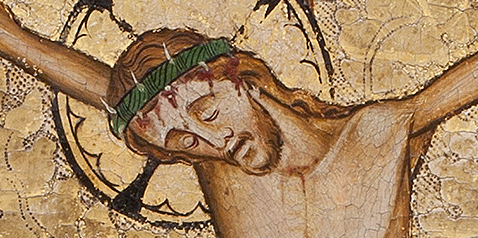
THE TRIPTYCH AS DEVOTIONAL MACHINE
Cologne
Triptych with Depiction of the Salvation Story, c. 1340–1350
This triptych was a veritable devotional machine: as the wings were solemnly opened, it would have come across as a kind of airlock through which the worshipper could pass from the hustle and bustle of everyday life into contemplative absorption.
First only the left-hand wing was opened, as we know from the arrangement of the bolt. There would appear, at a place indicated just before by the Angel of the Annunciation (painted on the outside), the wound in Christ’s side. The spear-thrust carried out to verify the death of the crucified victim was, even before the wing was fully open, clearly and completely visible. The Roman centurion Longinus is holding the spear with his left hand; the index-finger of his curled back right hand is pointing to the left, open, eye. The depiction refers to Christ’s first posthumous miracle, the healing of the blind Longinus by the blood streaming from the wound in the side. The consonance between the opened and the closed eye of Longinus on the one hand, and the opened left-hand wing and closed right-hand wing of the triptych on the other, is perfect: as long as the triptych is only half open, the pious user of the picture, like Longinus, is not yet fully sighted.
Only when the right-hand wing is opened does the salvation story unfold completely. The death on the Cross is followed now on the inside of the right-hand wing by Ascension and Pentecost: Jesus reveals Himself as the Christ and the Son of God. Triumphantly holding aloft a ‘speech bubble’ in the form of a scroll against a gold ground which provides plenty of space for the words to resonate, the good captain, so to speak a fully sighted alter ego of Longinus, can proclaim: ‘vere filius dei erat iste’ (‘Truly, this was the Son of God.’) Now the words in the ‘speech bubble’ of the Angel of the Annunciation on the outside of the left-hand wing ’gratia plena’ (‘full of grace’) are fulfilled. If we close the triptych once more, starting with this wing, we see for a brief moment both ‘speech bubbles’ side by side. The symmetry of the gestures of the angel and the captain draw attention to this.
This triptych probably once stood in the gallery of the church of the Poor Clares’ convent in Cologne, and is part of a group of works from there which are among the oldest surviving German paintings. It is probably a devotional picture that served the private meditation of the nuns.
The convent of the Poor Clares in Cologne was founded in 1304 and accepted upper-class women. The speed with which a love for art spread in such a milieu is evidenced by the book illuminations done by the nuns themselves around 1350. The triptych was created in a Cologne workshop outside the walls of the convent; the workshop also engaged in painting statues and providing designs for glass painting.
Cologne
c. 1340 – 1350
Triptych with Depiction of the Salvation Story
Oak, central panel 65 x 48 cm, wings each 65 x 24 cm (with original frame)
Collection of Ferdinand Franz Wallraf
Inv. no. WRM 0001
Photo: Rheinisches Bildarchiv Köln





